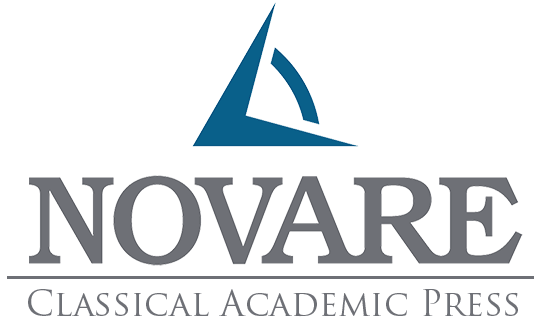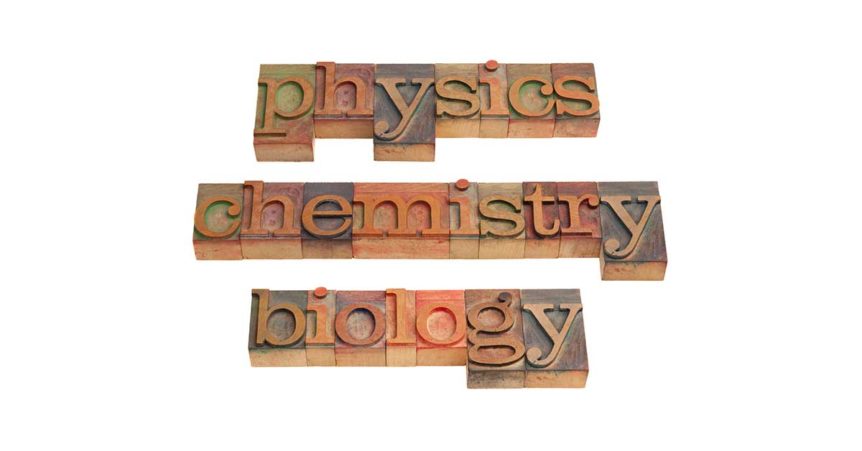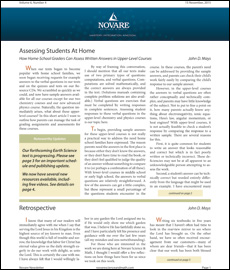Biology. Chemistry. Physics. It is by far the most common sequence of science courses in high schools, and has been the default program in American high school education for several decades. But the B-C-P sequence has been the subject of criticism from many educators and scientists for over a century. In our time when science scores and aptitude are in decline nationwide, critics express frustration that the benefits of a more integrated sequence and the experience gained from over a century of science education have not been implemented on a widespread basis.
Somewhat surprisingly, private schools and homeschooling groups, who have the freedom to change and improve their programs free from excessive bureaucracy, have largely followed the public schools on this matter. It seems that B-C-P is an ingrained method now having been in place for a few generations now. Even among those with a reform mentality, modifying the sequence does not rise to the level of a cause célèbre. Few educators consider if there is a better, more pedagogically advantageous sequence, and even if there is, the complications in modifying the existing one appear too daunting.
The order in which students will take high school science courses has been the subject of ongoing debate since the need for scientific studies first dawned upon the deliberations of 19th century school planners. An inchoate form of B-C-P was originally employed and has been the default sequence with some variations across the country for 125 years. Today, it suffers from being outdated and pedagogically inferior.
Since Novare Science & Math has taken a bold stance in advocating the so-called “physics first” sequence, our readers may be interested to know the interesting story about how American education arrived at B-C-P. (Please read the September 2013 Novare Newsletter for a thorough explanation of the physics first paradigm.)
The Beginning
In 1890, enrollment in secondary schools in the US was extremely low. About 200,000, less than 4% of the adolescent population attended high schools. But that figure was on the verge of exploding. Only ten years later, high school enrollment was 500,000. By 1
920 there were 2 million high school students nationwide.
Times were changing and the need for the populace to have some training in sciences became apparent in the increasingly sophisticated modern world. It was a time when spectacular scientific discoveries were being made at a breathtaking pace. The idea of carving out some time in the school day to teach new scientific discoveries was gaining currency. In 1892, the National Education Association (NEA) famously appointed a committee to make recommendations regarding the nation’s burgeoning schools. The so-called Committee of Ten was selected, and among its duties was the recommending of a component of science to be added to the public school program.
When the Committee of Ten submitted its initial report, the general body of NEA educators was not satisfied. A period of revision began in which various subject content was suggested and the sequence was shuffled around. It bears saying that some science courses at the time bore little resemblance to what they are today. Initially, physical geography, scarcely even a science, was recommended for 9th grade because it was the least abstract and mathematical.
Between 1900 and 1920, two new courses began to appear: General Science and General Biology. These became the most common courses for underclassman. Biology at that time was an amalgamation of zoology, botany, anatomy and physiology that consisted mostly of identifying and categorizing. This course replaced geography and was deemed suitable for younger students who were assumed to lack the mental capacity for the abstract sciences of chemistry and physics. (The presumption of low cognitive ability on the part of 9th and 10th graders seems to have been a common theme in the deliberations of educators.)
Meanwhile, opinions continued to vary over which between chemistry and physics should precede the other in the upper grades. The chairman of the Committee of Ten was Ira Remsen, a renowned M.D. and chemist known today for the discovery of saccharine. Under
his leadership a majority decided initially to place chemistry before physics. Amazingly, his committee’s report acknowledged that this sequence was not the logical one, but did not specify a reason for placing chemistry first. The most likely reason is the consideration that the maximum mathematical foundation was needed for physics and it was therefore reserved for the final year of high school.
William J. Waggener, professor of Natural Philosophy at the University of Colorado, dissented with the majority, saying that chemistry was clearly the most abstract science and should be placed at the end of the sequence. More importantly, it just made pedagogical sense. He wrote, “…elementary physics forms a desirable basis for the study of the elements of Chemistry. On the other hand, a knowledge of elementary chemistry is but to a small extent helpful in getting the knowledge of physics expected in the high school course.” His proposal amounts to a logical sequence of integrative learning rather than one based on student’s inability to understand.
In the end, the Committee of Ten actually adopted Waggener’s opinion in placing physics before chemistry. But they gave the simple (if inelegant) explanation that most students did not finish high school anyway, and it was thought that if students would miss out on any subject, it should be the more abstract of the two: chemistry. Furthermore, chemistry was what today we would consider a new and “cutting edge” field. J.J Thompson had not yet discovered the electron. The periodic table only had about 70 elements. Making chemistry its own high school course at all was a novel idea, but the tremendous potential of the benefits to the human race helped make a place for chemistry in the public school project.
One feature relevant to our topic is the fact that in the late 19th century school curriculum was dominated by the study of the classics. The main question of education prior to 1890 dealt with how many languages a student would learn. Only gradually (and probably reluctantly) did the dominance of the humanities give some space to science. In 1896 the Committee on College Entrance Requirements of the NEA proposed that one high school science credit should be required for college entrance. All but a few states adopted this recommendation and continued the practice for much of the 20th century, treating sciences the same way electives are treated today.
To be clear, the NEA had no regulating power, a fact that is apparent by the variance in practice that prevailed for years from state to state. Their final recommendations were presented, with physics in 10th grade and chemistry in 12th, a P-C sequence. Some states followed the NEA recommendation, but practices were not uniform, and between 1910 to 1950 there was a gradual reversing of the recommendation, putting chemistry ahead of physics.
Even as the norm for high school attendance lengthened to the full four years, there was little consensus among states about which sciences should be required and what order they should appear in the curriculum. Then in 1983, the publication of A Nation At Risk: The Imperative for Educational Reform by Ronald Reagan’s National Commission on Excellence in Education bolstered science education nationwide. Educational methods and standards were shockingly impoverished. The report’s famously said, “If an unfriendly foreign power had attempted to impose on America the mediocre educational performance that exists today, we might well have viewed it as an act of war.”
Among the commission’s recommendations were included increasing science credit requirements to three years although no sequence was specified. The sequence that prevailed and finally took hold nationwide seems to have been the closest one at hand: biology in 9th grade, followed by chemistry, saving physics for last.
We can grant that the overall influence of the commission was positive. It motivated schools across the nation to greater academic rigor in all subjects and elevated requirements for graduation. However, the commission’s work has been criticized for being a product of bureaucrats. The 18-person committee consisted of 12 administrators plus a sprinkling of token figures which included only one actual teacher. There were no students, no recent graduates, no parents, PTA members, social workers, and not a single academic expert in education. Such a committee apparently lacked the bandwidth to consider implementing a logical order of science courses, and the opportunity was lost.
In the 1990’s some educators began advocating a revised sequence that came to be called physics first. Something of a small movement began and gained a little traction in some schools. Leon Lederman, the scholar and Fermilab scientist famous for his work is discovering the Higgs Boson, noted that by 2001 he knew of more than 100 schools both private and public that had adopted a physics first approach. A passionate advocate of physics first, Lederman quotes a report from the National Research Council titled Physics in a New Era: “Because all essential biological mechanisms ultimately depend on physical interactions between molecules, physics lies at the heart of the most profound insights in biology.” Chemistry also relies heavily on the foundation of physics. He says, “…as any reader of [James D. Watson’s] The Double Helix knows, a knowledge of a lot of chemistry is required to begin a study of modern molecular-based biology.”
Which brings us to today. A mini-revolution is at the ready to bring great improvement to the high school science experience of millions of students with the simple rearrangement of courses into a sequence that allows one subject to flow logically into another. Those who set the bar too low by underestimating the cognitive abilities of contemporary high school students perpetuate the sad trend toward postponement of growing up. They also ignore evidence from international high school programs in which ordinary 14-year-olds students can and do achieve and understand, passing up the United States steadily for some decades in science and math performance.
Dispelling some false notions
The first assumption that can be dispensed with is that physics only dwells in the realms of higher math. But a freshman physics course can cover much valuable content without going near calculus or trigonometry. An algebra-based course can cover essential scientific material and lay an excellent foundation for chemistry and molecular biology.
More daunting may be the prospect of modifying a school program, or for homeschoolers, making changes after a student already began with biology. For homeschoolers, every situation will be different, but not difficult. The principles and reasoning of physics first and mastery-learning can be applied to construct a more beneficial sequence for your student. If she had biology in 9th grade, go ahead and restart with introductory physics in 10th. Build on the foundation you are able to lay.
Schools may find shuffling an existing science sequence a dizzying prospect to consider. I can only point out that many schools have done it. New high schools that are still adding grades obviously have the perfect opportunity to implement physics first. Established schools have more to work out, but it can be done. Novare has worked with multiple schools to successfully implement physics first. Those schools weathered the challenges to do what was best for students. The following case study may shed light on some of the considerations.
Case Study: Horizon Prep, Rancho Santa Fe, California
In the June of 2013, we had the pleasure of meeting Dr. Jeffrey Pratt at the Novare Science & Math exhibitor booth at an education conference. His school, Horizon Prep near San Diego, CA, was within weeks of launching their first 9th grade class, and they were staffing and preparing for the standard B-C-P science sequence. We began a conversation with Jeff that extended over two days at the conference. As Director of Program & Curriculum Development for Horizon Prep, he explained that the high school science sequence that was already settled. He was intrigued by the physics first approach, but felt that his hands were tied. On the last day of the conference, Jeff thanked us for the encouragement, but the difficulty of California standards and students transferring from B-C-P schools into Horizon Prep seemed to be an insurmountable problem.
A week later, we got a phone call from Jeff. They had changed their minds, he said. He and his committee had not been able to escape the advantages offered by a superior science sequence, and they were committed to building a strong science program. “Basically, we’ve decided to do what’s right rather what the state of California says.” It took great courage to make a decision that, while reasonable and beneficial, went against the routine practice of surrounding schools. Later, in October that year, Jeff and several of his colleagues visited Regents School of Austin where Novare founder John Mays was teaching, and which had converted their science department to physics first under his leadership years before. Observing a school where the science program was turning out such highly prepared and competent students reaffirmed to the group that their decision was the right one.
Dr. Jorge Munoz-Burgos teaches science at Horizon Prep. He became very excited about the approach and has been an advocate of physics first to other schools. He talks about how smart an integrated science program is and how such an approach is exactly in accordance with a classical educational approach, which is the model of Horizon Prep.
This year Horizon Prep will graduate their first class of seniors. I asked Jeff if there had been difficulties with students transferring from B-C-P schools. He said transfers had been few but that they had handled them on a case by case basis. He points out that the problem obviously doesn’t exist in the case of freshmen. And students rarely transfer away from a school for 12th grade; most have completed their science requirements by then anyway. That leaves only sophomores and juniors. There is not a simple answer that works for every student transferring in, but in each case the school counselors are able to develop a plan to cover the necessary classes. If they come in with biology completed, for example, they put the student in 9th grade physics. “It hasn’t been a big issue,” he said.
There are many things that need to be changed in order to improve science education. Changing the sequence of science course is just one. But coupled with other strategies and methods that enable students to master and internalize concepts in science, the physics first sequence transforms a student’s experience. Bad habits and practices have been handed down uncritically for generations. It is time to do right by our students rather than perpetuating poor methods by simply imitating the majority.
I encourage you to investigate further by reading the September 2013 Novare Newsletter available on our website archive. If you would like more information about improving your student’s science learning, please contact us
Bibliography
Babones, Salvatore. “Education ‘Reform’s’ Big Lie: The Real Reason the Right Has Declared War on Our Public Schools.” Salon.com RSS, 9 May 2015, www.salon.com/2015/05/09/education_reforms_big_lie_the_real_reason_the_right_has_declared_war_on_our_public_schools/.
Lederman, Leon, “Revolution in science education: Put physics first!” Physics Today vol. 54, 2001, pp. 11-12, scitation.aip.org/content/aip/magazine/physicstoday/article/54/9/10.1063/1.1420496
Pauly, Philip J. “The Development of High School Biology: New York City, 1900-1925.” Isis, vol. 82, no. 4, 1991, pp. 662–688. www.jstor.org/stable/233320.
Sheppard, Keith, and Dennis M. Robbins. “Chemistry, The Central Science? The History of the High School Science Sequence.” Journal of Chemical Education, vol. 82, no. 4, 2005, pp. 561–566.


